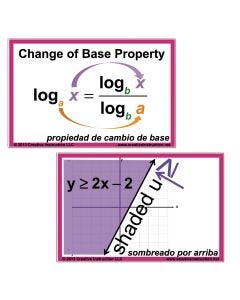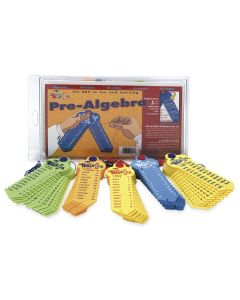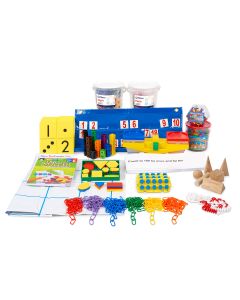Daily Warm-Ups: Mathematics for Common Core State Standards - Algebra
For your Common Core curriculum.
Grades 9-12.
Ideal for quick reinforcement or to fill a spare bit of time! The targeted problems directly address Common Core State Standards and Mathematical Practices. Each problem builds problem-solving skills and strengthens understanding of key concepts. 162 pages.
CCSS Product Alignment
HSN.RN.2 Rewrite expressions involving radicals and rational exponents using the properties of exponents.
HSN.CN.9 (+) Know the Fundamental Theorem of Algebra, show that it is true for quadratic polynomials.
HSN.VM.6 (+) Use matrices to represent and manipulate data, e.g., to represent payoffs or incidence relationships in a network.
HSN.VM.8 (+) Add, subtract, and multiply matrices of appropriate dimensions.
HSN.VM.9 (+) Understand that, unlike multiplication of numbers, matrix multiplication for square matrices is not a commutative operation, but still satisfies the associative and distributive properties.
HSA.SSE.2 Use the structure of an expression to identify ways to rewrite it. For example, see x4 - y4 as (x²)² - (y²)², thus recognizing it as a difference of squares that can be factored as (x² - y²)(x² + y²).
HSA.SSE.3a Factor a quadratic expression to reveal the zeros of the function it defines.
HSA.SSE.3b Complete the square in a quadratic expression to reveal the maximum or minimum value of the function it defines.
HSA.SSE.3c Use the properties of exponents to transform expressions for exponential functions. For example the expression 1.15t can be rewritten as (1.151/12)12t ? 1.01212t to reveal the approximate equivalent monthly interest rate if the annual rate is 15%.
HSA.APR.6 Rewrite simple rational expressions in different forms, write a(x)/b(x) in the form q(x) + r(x)/b(x), where a(x), b(x), q(x), and r(x) are polynomials with the degree of r(x) less than the degree of b(x), using inspection, long division, or, for the more complicated examples, a computer algebra system.
HSA.CED.1 Create equations and inequalities in one variable and use them to solve problems. Include equations arising from linear and quadratic functions, and simple rational and exponential functions.
HSA.CED.2 Create equations in two or more variables to represent relationships between quantities, graph equations on coordinate axes with labels and scales.
HSA.CED.3 Represent constraints by equations or inequalities, and by systems of equations and/or inequalities, and interpret solutions as viable or nonviable options in a modeling context. For example, represent inequalities describing nutritional and cost constraints on combinations of different foods.
HSA.REI.1 Explain each step in solving a simple equation as following from the equality of numbers asserted at the previous step, starting from the assumption that the original equation has a solution. Construct a viable argument to justify a solution method.
HSA.REI.3 Solve linear equations and inequalities in one variable, including equations with coefficients represented by letters.
HSA.REI.4a Use the method of completing the square to transform any quadratic equation in x into an equation of the form (x - p)² = q that has the same solutions. Derive the quadratic formula from this form.
HSA.REI.4b Solve quadratic equations by inspection (e.g., for x² = 49), taking square roots, completing the square, the quadratic formula and factoring, as appropriate to the initial form of the equation. Recognize when the quadratic formula gives complex solutions and write them as a ± bi for real numbers a and b.
HSA.REI.6 Solve systems of linear equations exactly and approximately (e.g., with graphs), focusing on pairs of linear equations in two variables.
HSA.REI.7 Solve a simple system consisting of a linear equation and a quadratic equation in two variables algebraically and graphically. For example, find the points of intersection between the line y = -3x and the circle x² + y² = 3.
HSA.REI.9 (+) Find the inverse of a matrix if it exists and use it to solve systems of linear equations (using technology for matrices of dimension 3 x 3 or greater).
HSA.REI.10 Understand that the graph of an equation in two variables is the set of all its solutions plotted in the coordinate plane, often forming a curve (which could be a line).
HSA.REI.12 Graph the solutions to a linear inequality in two variables as a half-plane (excluding the boundary in the case of a strict inequality), and graph the solution set to a system of linear inequalities in two variables as the intersection of the corresponding half-planes.
HSF.IF.1 Understand that a function from one set (called the domain) to another set (called the range) assigns to each element of the domain exactly one element of the range. If ƒ is a function and x is an element of its domain, then ƒ(x) denotes the output of ƒ corresponding to the input x. The graph of ƒ is the graph of the equation y = ƒ(x).
HSF.IF.2 Use function notation, evaluate functions for inputs in their domains, and interpret statements that use function notation in terms of a context.
HSF.IF.4 For a function that models a relationship between two quantities, interpret key features of graphs and tables in terms of the quantities, and sketch graphs showing key features given a verbal description of the relationship. Key features include: intercepts, intervals where the function is increasing, decreasing, positive, or negative, relative maximums and minimums, symmetries, end behavior, and periodicity.
HSF.IF.5 Relate the domain of a function to its graph and, where applicable, to the quantitative relationship it describes. For example, if the function h(n) gives the number of person-hours it takes to assemble n engines in a factory, then the positive integers would be an appropriate domain for the function.
HSF.IF.6 Calculate and interpret the average rate of change of a function (presented symbolically or as a table) over a specified interval. Estimate the rate of change from a graph.
HSF.IF.7a Graph linear and quadratic functions and show intercepts, maxima, and minima.
HSF.IF.7b Graph square root, cube root, and piecewise-defined functions, including step functions and absolute value functions.
HSF.IF.7c Graph polynomial functions, identifying zeros when suitable factorizations are available, and showing end behavior.
HSF.IF.7d (+) Graph rational functions, identifying zeros and asymptotes when suitable factorizations are available, and showing end behavior.
HSF.IF.7e Graph exponential and logarithmic functions, showing intercepts and end behavior, and trigonometric functions, showing period, midline, and amplitude.
HSF.IF.8a Use the process of factoring and completing the square in a quadratic function to show zeros, extreme values, and symmetry of the graph, and interpret these in terms of a context.
HSF.IF.8b Use the properties of exponents to interpret expressions for exponential functions. For example, identify percent rate of change in functions such as y = (1.02)t, y = (0.97)t, y = (1.01)12t, y = (1.2)t/10, and classify them as representing exponential growth or decay.
HSF.IF.9 Compare properties of two functions each represented in a different way (algebraically, graphically, numerically in tables, or by verbal descriptions). For example, given a graph of one quadratic function and an algebraic expression for another, say which has the larger maximum.
HSF.BF.1a Determine an explicit expression, a recursive process, or steps for calculation from a context.
HSF.BF.1b Combine standard function types using arithmetic operations. For example, build a function that models the temperature of a cooling body by adding a constant function to a decaying exponential, and relate these functions to the model.
HSF.BF.1c (+) Compose functions. For example, if T(y) is the temperature in the atmosphere as a function of height, and h(t) is the height of a weather balloon as a function of time, then T(h(t)) is the temperature at the location of the weather balloon as a function of time.
HSF.BF.5 (+) Understand the inverse relationship between exponents and logarithms and use this relationship to solve problems involving logarithms and exponents.
HSF.LE.1a Prove that linear functions grow by equal differences over equal intervals, and that exponential functions grow by equal factors over equal intervals.
HSF.LE.1b Recognize situations in which one quantity changes at a constant rate per unit interval relative to another.
HSF.LE.1c Recognize situations in which a quantity grows or decays by a constant percent rate per unit interval relative to another.
HSF.LE.2 Construct linear and exponential functions, including arithmetic and geometric sequences, given a graph, a description of a relationship, or two input-output pairs (include reading these from a table).
HSF.LE.4 For exponential models, express as a logarithm the solution to abct = d where a, c, and d are numbers and the base b is 2, 10, or e, evaluate the logarithm using technology.
HSF.LE.5 Interpret the parameters in a linear or exponential function in terms of a context.
HSF.TF.7 (+) Use inverse functions to solve trigonometric equations that arise in modeling contexts, evaluate the solutions using technology, and interpret them in terms of the context.
HSS.ID.6a Fit a function to the data, use functions fitted to data to solve problems in the context of the data. Use given functions or choose a function suggested by the context. Emphasize linear, quadratic, and exponential models.
HSS.ID.6b Informally assess the fit of a function by plotting and analyzing residuals.
HSS.ID.6c Fit a linear function for a scatter plot that suggests a linear association.
-
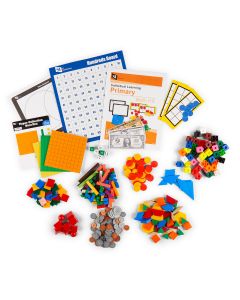 Primary Individual Learning Math KitProduct Number: NE30016In Stock
Primary Individual Learning Math KitProduct Number: NE30016In Stock -
 Junior Individual Learning Math KitProduct Number: NE30017In Stock
Junior Individual Learning Math KitProduct Number: NE30017In Stock -
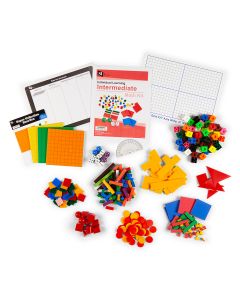 Intermediate Individual Learning Math KitProduct Number: NE30018In Stock
Intermediate Individual Learning Math KitProduct Number: NE30018In Stock -
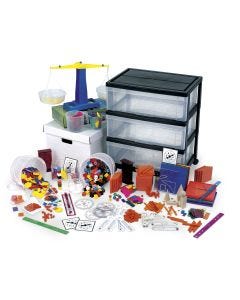 Nasco Intermediate Math Kit with StorageProduct Number: TB15923In Stock
Nasco Intermediate Math Kit with StorageProduct Number: TB15923In Stock -
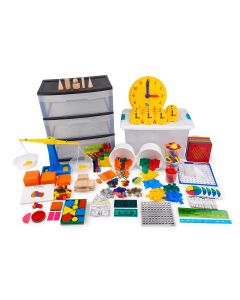 Nasco Primary Math Kit with StorageProduct Number: TB15924In Stock
Nasco Primary Math Kit with StorageProduct Number: TB15924In Stock -
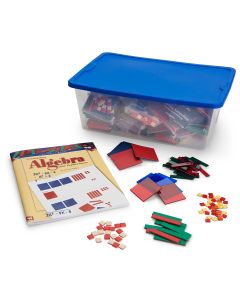 Nasco Algebra Tiles™ Classroom SetProduct Number: TB17249In Stock
Nasco Algebra Tiles™ Classroom SetProduct Number: TB17249In Stock -
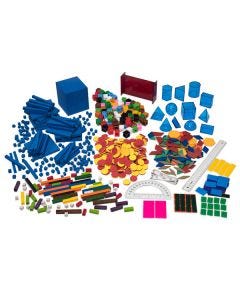 Math Methods Kit DProduct Number: TB26429In Stock
Math Methods Kit DProduct Number: TB26429In Stock













